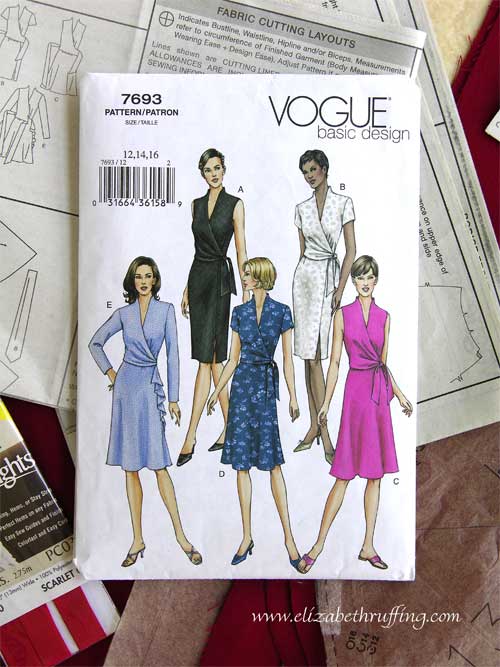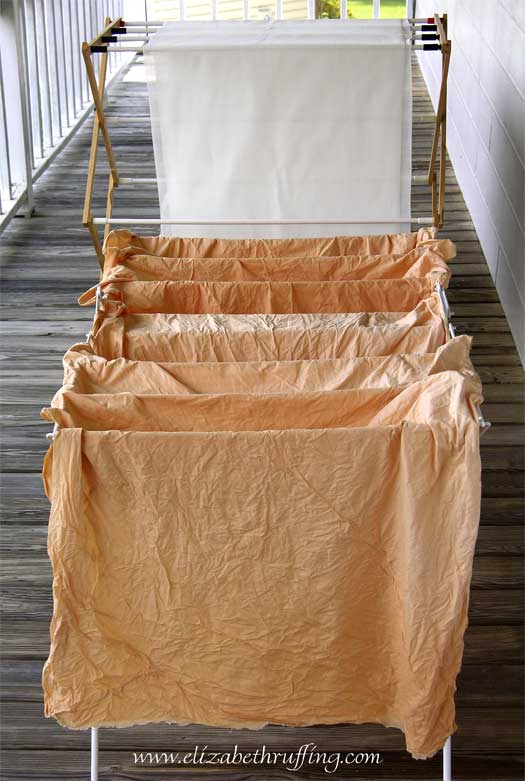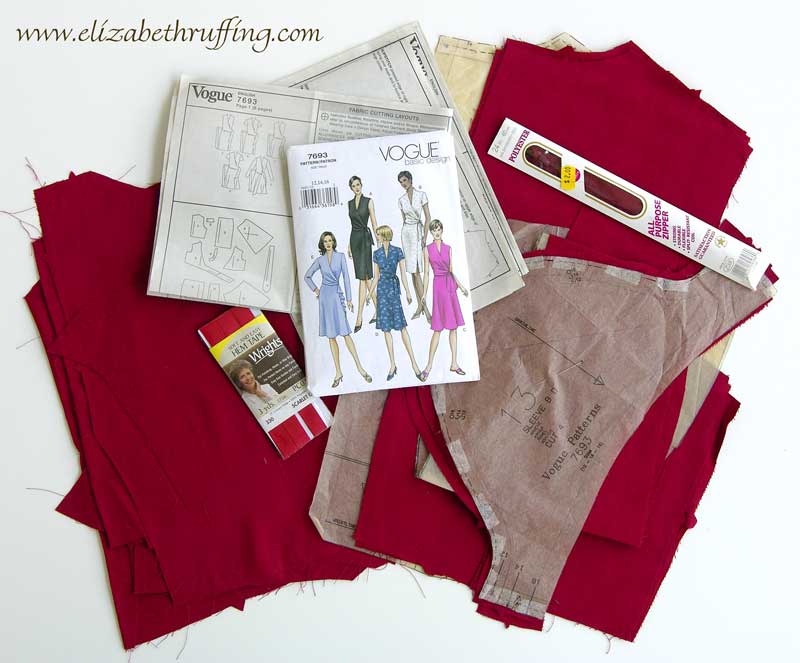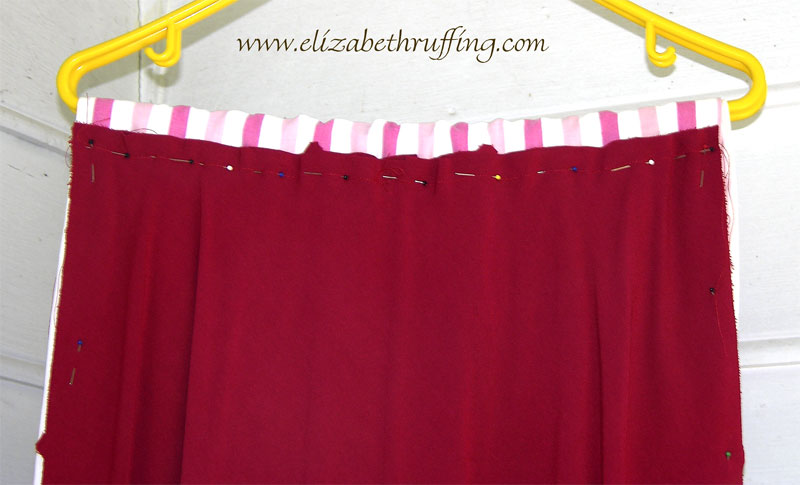 I went rummaging through my piles to resurrect one of the my many partially-made sewing projects and picked out this wrap dress from Vogue patterns, Vogue 7693, view D.
I went rummaging through my piles to resurrect one of the my many partially-made sewing projects and picked out this wrap dress from Vogue patterns, Vogue 7693, view D.
 I have cut it out in red rayon challis, which I prewashed before, like the peach version (above) of the same fabric I bought a couple of days ago. I preshrank both fabrics by washing them in warm water, by hand, and then hung them to dry because that is how I plan to wash any garments made from these fabrics in the future. I presoaked my Fusi-Knit interfacing in warm water and hung it to dry as well.
I have cut it out in red rayon challis, which I prewashed before, like the peach version (above) of the same fabric I bought a couple of days ago. I preshrank both fabrics by washing them in warm water, by hand, and then hung them to dry because that is how I plan to wash any garments made from these fabrics in the future. I presoaked my Fusi-Knit interfacing in warm water and hung it to dry as well.
I use Fusi-Knit for a lot of garments, except for the pieces that need to be stiff, like collars and cuffs, because it doesn’t effect the drape of fabrics as much as the nonwoven fusibles. I tend to prefer natural fiber-based fabrics for garment construction like cotton, rayon, Tencel, and silk. Sometimes I will use acetate for linings.
 When I looked at what I had assembled already for this dress, I knew right away why I put it in a box for much later. It is a beautiful dress. I have made View B before, but…I cut the top part out in a size 12. I am a size 14. I believe I read that Vogue patterns run a little large on top, compared to patterns from other companies. Why I chose to believe this was an issue for me, I do not know. I have made clothes from Vogue patterns for years and they always fit me. Plus, I am fairly broad-shouldered.
When I looked at what I had assembled already for this dress, I knew right away why I put it in a box for much later. It is a beautiful dress. I have made View B before, but…I cut the top part out in a size 12. I am a size 14. I believe I read that Vogue patterns run a little large on top, compared to patterns from other companies. Why I chose to believe this was an issue for me, I do not know. I have made clothes from Vogue patterns for years and they always fit me. Plus, I am fairly broad-shouldered.
This is a common sewing pitfall. It is hard to explain why it is so tempting to believe you are a size smaller than it says on the envelope, but, trust me, you are not! Always measure yourself and get a friend to read those numbers. If you trust your friend enough to help take your measurements, trust her when she writes down the results. I swear, I catch myself taking an inch off all the time. It’s completely bizarre and unintentional. I may fit into a size 6 or an 8 in the store, but in the pattern world, I am a size 14. It hurts, but it’s true. If you can’t stand it, use European sizes instead. In Europe, I am a size 40. That means nothing to me! 🙂
So, I see I have hand-basted the corrected sewing lines onto some of the pieces, and I will have to do the same for the rest. Correct fit makes or breaks a garment, and too small is never flattering.
 The skirt of this dress is bias-cut and has been hanging for I don’t know how long. It should have grown as much as it is going to by now. This is important for bias-cut skirts. Stay stitch 1/2 inch from the raw edge across the top of the skirt pieces. Pin the front piece of the skirt to the back piece of the skirt at the sides. (The side seam allowances have already been cut 1 inch wide instead of 5/8 inch, to compensate for the narrowing of the skirt as it grows. They will be readjusted later depending on fit.) Find some stiff fabric to drape over a hanger and pin the top edges of the pinned-together skirt pieces, through both layers at once, along the stitch lines, in a straight, horizontal line to the stiff fabric. I have used an old sheet as my stiff fabric.
The skirt of this dress is bias-cut and has been hanging for I don’t know how long. It should have grown as much as it is going to by now. This is important for bias-cut skirts. Stay stitch 1/2 inch from the raw edge across the top of the skirt pieces. Pin the front piece of the skirt to the back piece of the skirt at the sides. (The side seam allowances have already been cut 1 inch wide instead of 5/8 inch, to compensate for the narrowing of the skirt as it grows. They will be readjusted later depending on fit.) Find some stiff fabric to drape over a hanger and pin the top edges of the pinned-together skirt pieces, through both layers at once, along the stitch lines, in a straight, horizontal line to the stiff fabric. I have used an old sheet as my stiff fabric.
 The top of the skirt is pinned to the sheet, and the sides are hanging loose, pinned only to each other. Leave the skirt hanging for a couple of days. This allows the fabric to settle into its new shape. This will help tremendously when you are ready to hem the dress. Bias-cut garments have a way of growing unevenly when they are hanging in your closet if you skip this step.
The top of the skirt is pinned to the sheet, and the sides are hanging loose, pinned only to each other. Leave the skirt hanging for a couple of days. This allows the fabric to settle into its new shape. This will help tremendously when you are ready to hem the dress. Bias-cut garments have a way of growing unevenly when they are hanging in your closet if you skip this step.
I have now spent more time blogging about my dress than I have sewing it! I will have to do something about this.





